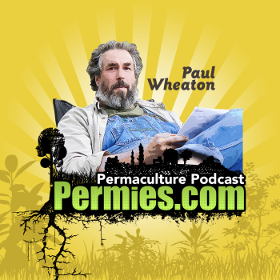 Listen Online
Listen Online  Download
Download  Get all of the Podcasts in convenient, giant zip files
Get all of the Podcasts in convenient, giant zip files  Subscribe on iTunes
Subscribe on iTunes Summary
Summary
Paul’s permaculture smackdown continues into chapter three of Sepp Holzer’s “Desert or Paradise” with Mark, Opalyn, Kyle, and Katie.
“The symbiosis of interactions, as explained on page 13, plants supply needed nutrients to eachother – often one plant releases nutrients at a time when its neighbour needs them. The earth, in polycultures, has ideal roots at all depths, and is kept moist at all times. Deep roots, taproots, and shallow roots, create the perfect storage body for water and nutrients [unintelligible] are used throughout. Each plant species has its own pest – bark beetles, the caterpillars of the cabbage butterfly, or carrotflies, only attack their respective hosts. In reality, these so-called pests are useful regulators – they prevent over-population and keep nature balanced. In polycultures, I might lose a few plants, but never the whole crop. Whereas in monocultures, whole crops get wiped out. When that happens, the farmer starts using pesticides.” On that note, Paul is hosting a master gardener class in January 2022 that’s being taught by Helen Atthowe, who also taught in Missoula for 17 years, and even introduced Paul to Masanobu Fukuoka when he attended her first lesson!
“A polyculture containing at least 50 percent deciduous trees is the best fire protection. The trees protect eachother as they contain lots of water.” It should be noted, however, that not all deciduous trees are equally fire-resistant. Case in point: eucalyptus. Despite some varieties being losing their leaves in winter, they are commonly known as “gasoline trees” for how much they like to catch fire.
“Trees and other plants with varying heights and density in a polyculture protect hail, storm, sun, and frost. I make best use of this symbiosis with progressive cultivation. Sun-loving plants shade more sensitive ones, and frost-sensitive plants are protected from the morning sun. In polycultures, a natural rejuvenation takes place where plants self-seed and the older ones protect the new growth. The habitat looks after itself and I have very little work as young offshoots distract game from the cultivated trees.”
Relevant Threads
2022 Certified Garden Master Course with Helen Atthowe
Soil forum
Trees forum
Support the Empire
Help support the empire and get all of the podcasts in a bundle
here in the digital market at permies.
To support production of these podcasts, make a donation
here at Paul's Patreon page.
 This podcast was made possible thanks to:
This podcast was made possible thanks to:
Dr. Hugh Gill Kultur
Eivind W. Bjørkavåg
Suleiman, Karrie, and Sasquatch
Kyle Neath
Bill Crim
anonymous
Kerry JustTooLazy
Jocelyn Campbell
Chris Sugg
Sasquatch
Bill Erickson
G Cooper
Dominic Crolius
havokeachday
Penny McLoughlin
Mehron Kugler
Julia Winter, world's slowest mosaic artist
Pasquale DeAngelis
Greg Martin
Mark
Sean Benedict
Rita Bliden
Dana Martin
Candace Dahlk
Keith Kuhnsman
Eric Tolbert
Matthew Stone
Nuno Marta
Polly Jayne Smyth
Opalyn Brenger
ellen fisher
Eliot Mason
Katie Young
Ivar Vasara
JMBlackwater226R
Nathan Hale











